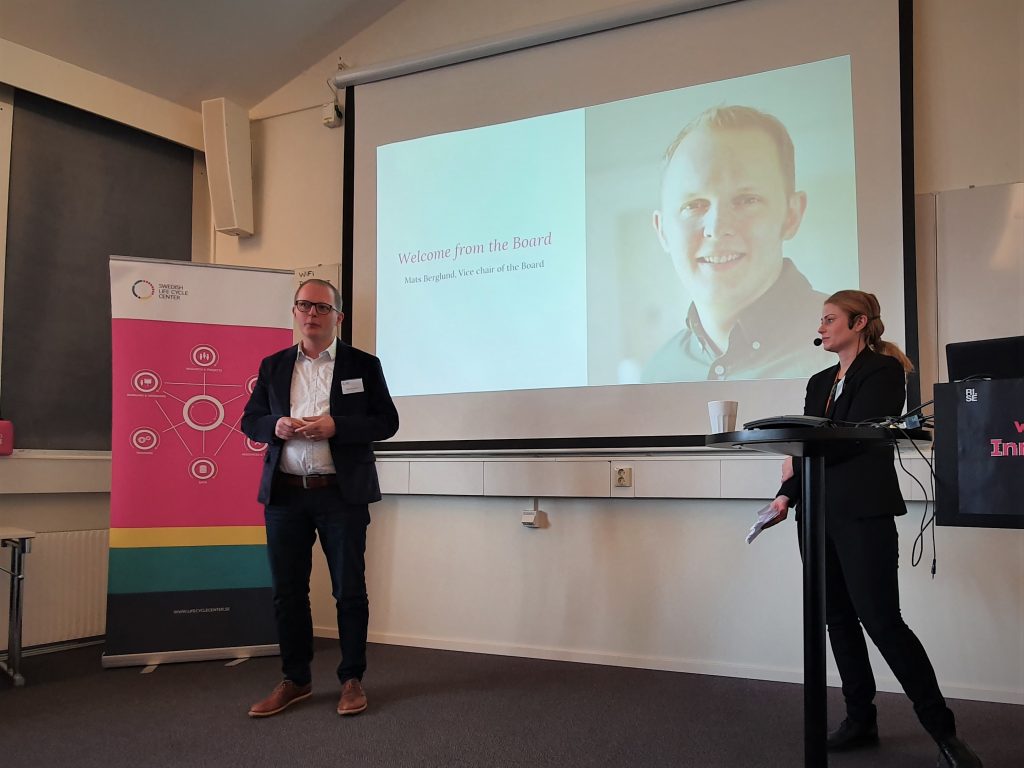The European Product Environmental Footprints – on the network conference agenda
On Thursday, February 20, it was time for the network conference – Let’s meet and talk LCA – about EU Product Environmental Footprints! The conference was arranged in Stockholm by the Swedish Life Cycle Center within the project Swedish platform for the life cycle perspective. The conference gathered 60 life cycle professionals from the network to learn more about, discuss and share their experiences on this important topic. The main focus for the afternoon was the Environmental footprint transition phase – from methodological discussions to benefits and obstacles for the application and policy development. On the agenda was presentations about EU Environmental footprint from different perspectives and a session of a round table discussions on the same topic.
Anna Wikström, acting Director, together with Mats Berglund, vice Chair of the board, welcomed the participants which consisted of partners, guests from organizations interested in becoming partner to Swedish Life Cycle Center and students. The day continued with a presentation from one of the newest partners to the center. Erik Nellström, product property owner, and Dora Burul, development engineer, at Scania, presented how Scania works with LCA and the life cycle perspective to build knowledge and improve on set targets.
Anna Wikström and Mats Berglund welcomed and introduced the participants.
The afternoon continued with the session on EU Environmental Footprint, which was moderated by Anna Woodhouse from RISE Swedish Research Institute of Sweden. The first presenter was Imola Bedo, Policy Officer European Commission and part of the Environmental Footprint team at the European Commission. She talked about the main objectives for developing Product Environmental Footprint (PEF) and what goals that could be achieved with PEF. Imola together with the next speaker Cecilia Mattsson, Swedish Environmental Protection Agency, gave the audience a good overview of the process for developing PEF as a method, what is happening now and in the future. They also presented how to be involved in the process during the transition phase from both a European perspective and a Swedish perspective. Imola also presented some parts of the European Green deal that is related to Product Environmental Footprint.
“Reliable, comparable and verifiable information also plays an important part in enabling buyers to make more sustainable decisions and reduces the risk of ‘green washing’. Companies making ‘green claims’ should substantiate these against a standard methodology to assess their impact on the environment. The Commission will step up its regulatory and non-regulatory efforts to tackle false green claims.” Imola Bedo during her presentation

Cecilia Mattsson presenting background and existing work with PEF from a Swedish perspective
Cecilia also presented that the Swedish Environmental Protection Agency is positive to PEF and its overall aim and showed a summary of the issues for considerations in future policy from the Nordic Environmental Footprint Discussion paper. That gave a very valuable overview of both existing tools and supplements needed when moving forward towards policymaking.
The introduction was followed up by two other presentations. EPD (Environmental Product Declaration) has some similarities and differences with PEF but what are they? That was the question that Gustav Sandin Albertsson from EPD International and IVL Swedish Environmental Research Institute answered during his presentation about EPD and its relation to PEF. The presentation clarified the key similarities and key differences between the two systems and also that some harmonization is ongoing. Anna Woodhouse, RISE, gave a presentation of the study of the Nordic agri-food sector and its attitudes to PEF. PEF will undoubted have impact on the industry and the study showed that PEF is a good thing since it levels the playfield and could be used for improvement but that it might be costly and there is a lack of knowledge and data.
After some coffee and fika there were time for the round table discussions: There where three topics to choose from; method, policy and industry. The noise of people talking about PEF from these different perspectives filled the rooms and did not stop until the bell rang and there where time to sum up and get back to the seminar room.

Round table discussions on PEF.
The key issues from each table were lifted during the summarizing panel that closed the day. Anna Woodhouse moderated the panel which was consisting of the moderators from each table. A selection of key things that were raised during the panel discussions were:
Increased transparency, harmonization and comparability on the beneficial side.
Time consuming, need for more PEFCR´s (Product Environmental Footprint Category Rules) and concerns that SMEs will not be able to tag along without further efforts to support them on the other side.
Thank you to the Swedish Life Cycle Center Expert Group Environmental Footprint for valuable input throughout the planning process of the conference. The Expert group has been running with financial support from the Swedish Energy Agency through the project Swedish platform for the life cycle perspective. A special thank you to Anna Woodhouse, RISE Research Institutes of Sweden for excellent moderating and to our discussion moderators and panelists Anna Björklund, Anna Widerberg, Gustav Sandin Albertsson, Kristian Jelse, Lena Landström, Sven-Olof Ryding and Tomas Rydberg for contributing to a wonderful discussion climate!
Info: This Network Conference was arranged by Swedish Life Cycle Center through the project Swedish platform for the life cycle perspective, funded by the Swedish Energy Agency and the Swedish Life Cycle Center partners.
More information:
If you are new to the EU Environmental footprint process you can read more about it here and if you are interested in knowing how the center is part of the process you can find information about that here.
Text: Maria Rydberg
Photo: Maria Rydberg and Anna Wikström

